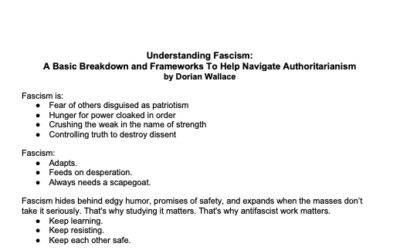by Jenni Walford – provokarte.com – Art-based Training in Awareness of Cult Dynamics in Business and Personal Development
Read as a PDF HERE
July 29, 2025
Corporate and therapy training programs often present themselves as cutting‑edge, science‑based, or spiritually transformative. Behind the polished branding, many borrow from the same manipulative playbook as cults and Large Group Awareness Trainings (LGATs) like est, Lifespring, and Landmark. These systems exploit human psychology to break down boundaries, create dependency, and generate revenue through endless “next level” trainings.
Below is a breakdown of the techniques most commonly used:
- Sacred Language and Jargon
Purpose: To isolate participants from their support networks and embed them in the worldview of the training. To create “in-groups” of people in-the-know and the impression of expertise where there is none.
How It Works
- Trainees are introduced to terms like container, alignment, breakthrough, integrity, holding space, shadow work, or full responsibility.
- Programs such as Co‑Active Training Institute (CTI), Landmark, and certain Gestalt or systemic constellations trainings cultivate a lexicon that is opaque to outsiders.
- Participants are often told that “others won’t understand this work” unless they also join the training. This creates separation from friends and family, even conflict, and subtly reorients loyalty toward the group.
Examples
- CTI coaches referring to “being in co‑active relationship” or “dancing in the moment.”
- Landmark leaders using terms like “rackets,” “breakdowns,” and “already always listening.”
- Gestalt and constellation trainings speaking of “the field,” “energetic entanglements,” or “the knowing system.”
- Phrases like “holding space for your shadow” or “finding full alignment with your integrity,” which sound meaningful inside the group but are incomprehensible to outsiders.
Impact
- Everyday experiences are reinterpreted through the training’s vocabulary.
- Participants begin to doubt their own judgment if it doesn’t align with the sacred language.
- Outside relationships weaken, making trainees more dependent on the program.
- Hypnosis and Hypnotic Activities
Purpose: To bypass critical thinking and induce suggestibility.
How It Works
- Guided visualizations, long meditations, “energy alignment” exercises, or silent staring games mimic classic hypnotic induction.
- Marathon schedules in corporate offsites, coach training intensives, and therapy workshops create mental fatigue, sometimes imposing 12- to 16‑hour days with limited breaks, with the plausible deniability of “getting your money’s worth”.
- Sudden shifts between high energy (dancing, shouting affirmations) and low energy (whispered reflections, meditations) create trance states.
Examples
- Landmark Forum’s late‑night sessions and sudden bursts of clapping or cheering.
- Tony Robbins’ firewalk events, which mix hypnosis, fatigue, and high‑intensity music.
- Some therapy trainings adopt breathwork, body scanning, or repetitive chants in ways indistinguishable from New Age cult practices.
Impact
- Participants confuse heightened emotion or dissociation with “”
- Rational evaluation is suppressed, making them more likely to accept dubious claims or up‑sell pitches.
- Group Cohesion and Team‑Building
Purpose: To generate emotional bonding and conformity.
How It Works
- Ice‑breakers quickly escalate into vulnerable self‑disclosure.
- Group applause, cheering, or “love‑bombing” rewards emotional displays.
- Those who resist sharing are labelled as “blocked,” “rigid,” or “in denial.”
- Team‑building exercises are framed as professional development but often mirror techniques from LGATs and encounter groups.
Examples
- Corporate HR retreats facilitated by Landmark graduates or systemic constellation trainers.
- “Authenticity circles” in coaching certifications that push intimate confessions unrelated to work.
- Lifespring‑style partner drills that mix humiliation and euphoria to bond the group.
Impact
- Participants experience temporary belonging and euphoria, which they associate with the program.
- Loyalty to the group is reinforced; doubt feels like betrayal.
- Unsolicited Touching and Boundary Violations
Purpose: To break down personal autonomy and normalize overreach.
How It Works
- Hugs, back rubs, hand‑holding, or “healing touch” are presented as bonding or support.
- People who refuse touch may be shamed, pathologized, or told they are “resistant” or “fearful.”
- Some experiential therapy programs (including Gestalt derivatives, family constellations, or somatic coaching) encourage touch without explicit, informed consent.
Examples
- Therapy training circles where participants are expected to hug after emotional disclosures.
- Corporate wellness workshops where facilitators press for physical interaction as part of “trust‑building.”
- Scenarios where saying “I don’t like to be touched” results in ridicule or accusations of emotional blockage.
Impact
- Normalizes coercion in a professional context.
- Deeply unsafe for neurodivergent participants or those with trauma.
- Violates ethical standards for consent in therapy or workplace training.
- Forced Vulnerability and Emotional Exploitation
Purpose: To manufacture dependency and exploit emotional openness.
How It Works
- Sharing circles, confession exercises, or “integrity processes” pressure participants to reveal personal traumas in front of the group.
- Silence or peer pressure ensures eventual compliance; those who hold back are shamed.
- Facilitators frame the program as a safe container, but disclosures are often leveraged to deepen loyalty or upsell further training.
Examples
- Co‑Active Coaching’s hallmark “sharing circles” and “powerful questions” that pry into participants’ private lives.
- Landmark Forum’s requirement to publicly commit to life changes and make recruitment calls to friends mid‑training.
- Therapy certifications that require live demonstrations of personal pain, filmed or witnessed by the group.
Impact
- Creates artificial intimacy and group dependency.
- Participants become less likely to leave, fearing judgement or exposure.
- Breaches professional ethics in therapy and coaching education.
- Confusion and Fragmented Epistemology*
Purpose: To disorient participants and elevate the trainer as the sole source of clarity.
How It Works
- Programs blend contradictory ideas: pseudo‑neuroscience, positive psychology, New Age spirituality, and corporate jargon.
- Facilitators oscillate between promising empowerment and demanding total obedience.
- Answers to confusion are always deferred to the “next level” course or certification.
Examples
- Coach trainings where neuroscience jargon is used alongside new age or “spiritual” concepts like chakra alignment, without evidence or coherence.
- Landmark’s philosophy of “You are 100% responsible” (borrowed from Scientology) alongside exercises designed to break participants’ sense of control.
- Therapy workshops where humanistic ideals are mixed with authoritarian practices, leaving participants uncertain which principles apply.
Impact
- Participants internalize the belief that their confusion is a personal failing.
- The trainer becomes the only trusted authority, increasing control and dependency.
- Cognitive overload masks unethical practices and financial exploitation.
- Leaves you more vulnerable to financial exploitation by thinking you need to do the next level to gain clarity.
- Authority Games and Power Dynamics
Purpose: To enforce hierarchy and obedience under the guise of professional or spiritual leadership.
How It Works
- Trainers cultivate charisma and demand reverence as “master coaches,” “senior faculty,” or “”
- Public shaming, sudden praise, and staged breakthroughs maintain dominance.
- Questioning the process is reframed as fear, ego, sabotage, or unwillingness to leave your comfort zone.
Examples
- Werner Erhard’s est trainings, where dissenters were humiliated and exits locked.
- Therapy trainings where lead facilitators override ethical boundaries, claiming it is “for your growth.”
- Coaching institutes that ostracize students who challenge the brand narrative.
Impact
- Participants suppress critical thinking to avoid punishment or humiliation.
- Hierarchies replicate cult leader dynamics in professional spaces.
- Authority figures become gatekeepers to both career advancement and perceived personal growth.
Conclusion
Corporate training, coaching education, and therapy workshops are fertile ground for cultic manipulation because they target motivated, self‑improving adults who trust the professional façade. Behind the glossy marketing lies a playbook honed by LGATs: isolate, confuse, break down, and rebuild loyalty in the trainer’s image.
The endgame is profit and control, not transformation. Participants leave convinced they are on a path to growth, often poorer, traumatized, and alienated from their own instincts. Recognizing these techniques is the first step toward reclaiming your autonomy, and protecting the next generation of learners from the weaponization of “personal development.”
*Epistemology (noun): The study of knowledge: how we know what we know, and what makes a belief justified or true.
Author Bio
Based in Spain, Jenni Walford has worked in business communication training for more than 25 years and spent many years immersed in the Gestalt therapy world. She now focuses on exposing how cult dynamics appear across personal growth culture, spiritual practices, corporate training, and HR programs. Her courses give people the tools to recognize and resist these tactics. Sign up here for updates: http://eepurl.com/c-Cc6X







